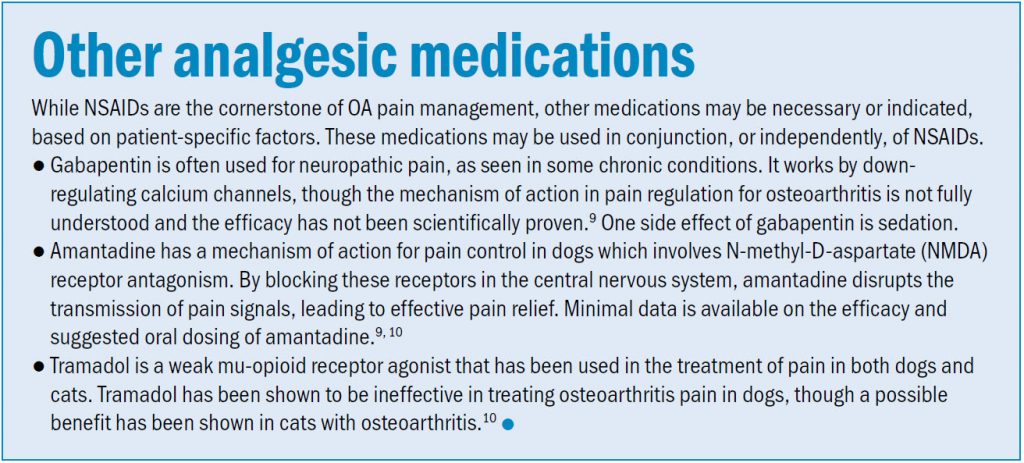
Osteoarthritis (OA), also known as degenerative joint disease, is a common condition in both dogs and cats. This is a chronic, painful, and progressive condition, characterized by articular cartilage degeneration and inflammation of one or more joints. It is estimated 20 percent of dogs older than one year of age, and up to 80 percent of dogs older than eight years have radiographic evidence and clinical signs of arthritis in the North American population.1
OA typically becomes more pronounced in older animals, with one study suggesting more than 50 percent of dogs are diagnosed between eight and 13 years of age.2 Clinical signs in canine patients may include lameness, decreased activity, decreased range of motion in the affected joint(s), swelling, stiffness, muscle atrophy, crepitus, and pain.
The true incidence of arthritis in cats is less easily determined as it can be much harder to identify clinically, though one study showed 61 percent of cats older than six years of age, and 90 percent of cats older than 12 years of age had radiographic evidence of arthritis in at least one joint.3, 11 Diagnosis of OA in cats is also more challenging, likely leading to underdiagnosis. Cats tend to mask their clinical signs, which can include difficulties jumping up, decreased activity, and gait changes.
The presence of clinical signs can lead to obvious changes in behavior owners can identify at home, aiding in the diagnosis of OA in the veterinary clinic. Pet owners can utilize checklists to look for specific behaviors. The Feline Musculoskeletal Pain Index (FMPI)4 and the Canine Brief Pain Inventory5 are validated tools that can help pet owners quantify the changes they are observing.
Veterinary assessment is critical in making a diagnosis of osteoarthritis. Though orthopedic exams may be more easily conducted in dogs compared to cats, veterinarians should be able to perform a gait analysis, joint assessment and manipulation, and pain assessment in animals presenting with signs related to OA. Diagnosis includes finding radiographic evidence of osteoarthritis, though this correlates poorly to degree of clinical signs, especially in cats.6
Managing osteoarthritis in companion animals is a lifelong process necessitating a multimodal approach to therapy. Pain management and comfort of the animal is a cornerstone of treatment, which can be primarily achieved through a pharmacologic approach. However, nonpharmacologic modalities, including weight management, controlled exercise, environmental modification, and joint supplementation should also be incorporated as appropriate for each patient.
Pharmacologic management of osteoarthritis focuses on reducing pain, which, in turn, helps increase mobility of the patient. There are multiple options that can be considered, based on the severity of disease, systemic health of the patient, and the veterinarian’s assessment. There is no one-size-fits-all approach to OA management in dogs and cats, and each patient requires an individualized approach.
Non-steroidal anti-inflammatory drugs (NSAIDs)
NSAIDs play a crucial role in managing OA in both dogs and cats. These medications work by inhibiting the enzyme cyclooxygenase (COX), which reduces the production of inflammatory prostaglandins, thereby alleviating pain and inflammation associated with the disease. Commonly prescribed NSAIDs for dogs include carprofen, meloxicam, and firocoxib; while cats are often prescribed meloxicam or robenacoxib. Grapiprant is also a newer medication available to manage chronic pain and works by blocking prostaglandin receptors.7
NSAIDs are effective in providing pain relief and improving joint function in both species. However, their use requires careful monitoring due to potential side effects. In dogs, these medications can cause gastrointestinal side effects, such as vomiting, diarrhea, and ulceration. They can also affect kidney function, highlighting the importance of routine monitoring in patients using NSAIDs chronically.
In cats, these medications are associated with a higher risk of adverse effects, particularly kidney injury. This risk has led to its more cautious use in cats, with lower doses and shorter treatment durations are often recommended. In the United States, robenacoxib is approved for short-term use in the post-operative period, but one study indicated administering to cats over a one-month period was well-tolerated, efficacious, and safe.8
Despite the potential side effects, NSAIDs remain an important tool in managing OA in both canine and feline patients. When used judiciously and under veterinary supervision, NSAIDs can significantly improve the quality of life for animals with OA by reducing pain and inflammation.
Anti-nerve growth factor monoclonal antibodies
Anti-nerve growth factor (NGF) monoclonal antibodies (mAb) have emerged as a promising treatment option to manage arthritis in dogs and cats. NGF is a protein that plays a key role in transmitting pain signals from the periphery to the central nervous system. In arthritis, elevated levels of NGF contribute to pain sensitization and inflammation in the joints.11 By targeting and neutralizing NGF, monoclonal antibodies can effectively reduce pain and inflammation associated with arthritis.11 This mechanism of action makes them particularly beneficial in cases where traditional pain medications such as NSAIDs are not well-tolerated or are ineffective.
Studies in both dogs and cats have shown promising results with anti-NGF mAb therapy. Frunevetmab (feline) and bedinvetmab (canine) treatments have been associated with improved mobility, reduced pain scores, and enhanced quality of life in arthritic animals. 12, 13 Additionally, because they target a specific pathway involved in pain and inflammation, anti-NGF mAbs may have fewer systemic side effects compared to traditional NSAIDs. However, it’s essential to note that while anti-NGF mAbs show great promise, they are relatively new and more research is needed to fully understand their long-term safety and efficacy in treating arthritis in dogs and cats.
Polysulfated glycosaminoglycans
Polysulfated glycosaminoglycan (PSGAG) is an injectable compound that has been shown to have beneficial effects in the treatment of osteoarthritis in dogs. PSGAG can help repair damaged joint cartilage and protect remaining cartilage.14 Additionally, PSGAG has some anti-inflammatory properties that may be helpful in reducing pain and improving joint function.14 There are currently no PSGAG products approved for cats in the United States.
Nutraceuticals and supplements
Nutritional supplements are commonly used as a component of multimodal management of OA. However, veterinarians should caution owners that not all supplements contain the same quantity and quality of the listed ingredients, and supplements with independent laboratory testing should be prioritized.
- Omega-3 fatty acids have been shown to decrease joint inflammation and cartilage degradation in dogs.15 Additionally, omega-3 fatty acid administration has been associated with increased weight-bearing, increased activity, and decreased lameness scores in both dogs and cats.15
- Glucosamine and chondroitin sulfate are commonly recommended by veterinarians and are believed to help with cartilage repair and rebuilding to help slow the progression of osteoarthritis.15 Dosing and efficacy data is limited.
- Green-lipped mussel may also be beneficial in managing osteoarthritis in dogs and cats due to its anti-inflammatory and chondrocyte modulatory properties. Studies have shown improvement in joint pain and joint swelling in both dogs and cats receiving this supplement.15 Dosing and efficacy data is limited.

Multimodal therapy for osteoarthritis includes not only pain management, but also weight management, environmental modifications, and other strategies that can improve the pet’s quality of life. Unsplash/Tucker Good
Nonpharmacologic therapies
Nonpharmacologic therapies are also valuable in managing arthritis in dogs and cats, offering holistic approaches to pain relief and improved mobility. While pharmacologic therapies remain the cornerstone of therapy, multimodal treatment can lead to better outcomes in patients.
- Weight management is crucial, as excess weight exacerbates joint strain. Controlled weight loss through diet and exercise can significantly reduce symptoms of osteoarthritis in both dogs and cats.
- Controlled exercise, such as use of an underwater treadmill or short, gentle walks, helps maintain joint flexibility and muscle strength without causing excessive stress. Encouraging cats to play with owners, or encouraging behaviors that simulate hunting or chasing behaviors can help increase exercise in a controlled manner.
- Physical therapy modalities, including massage, stretching, and range-of-motion exercises, can improve joint mobility and reduce pain. Other rehabilitation modalities, including acupuncture and cold laser therapy are also increasingly used to manage arthritis pain in both dogs and cats.
- Environmental modifications, such as providing orthopedic beds, ramps, and steps, can help arthritic pets access elevated surfaces more easily and reduce joint strain.
Osteoarthritis is a common and debilitating condition in dogs and cats, particularly in older animals. However, with advances in veterinary medicine, there are now numerous effective strategies available for managing arthritis and improving the quality of life for affected pets. From pharmacologic options, such as NSAIDs; to nonpharmacologic therapies, such as weight management, physical therapy, and nutritional supplements, veterinarians have a range of tools at their disposal.
Additionally, emerging treatments such as anti-NGF monoclonal antibodies offer promising alternatives for arthritis management. By combining these therapies in a multimodal approach tailored to each individual patient, veterinarians can help alleviate pain, reduce inflammation, and improve joint function, allowing dogs and cats with arthritis to lead more comfortable and active lives. Early diagnosis and proactive management are key to maximizing the benefits of these treatments and ensuring the best possible outcomes for pets living with arthritis.
Katie Krebs, DVM, MBA, DABVP (Canine and Feline) is an assistant professor in clinical primary care at the University of Pennsylvania’s Ryan Veterinary Hospital. Dr. Krebs graduated from the University of California (UC), Davis School of Veterinary Medicine, with an emphasis in small animal medicine. Krebs completed a small animal rotating internship at the Atlantic Veterinary College in Prince Edward Island, Canada before completing a residency in Canine/Feline practice, American Board of Veterinary Practitioners (ABVP), and MBA at Virginia Tech. Her research interests include pain management of osteoarthritis in cats, preventative care and business education, and implementing telehealth for improved client communication.
References
- Johnston S. A. Osteoarthritis – joint anatomy, physiology, and pathobiology. Veterinary Clinics of North America-Small Animal Practice27, 699–723 (1997).
- Anderson KL, O’Neill DG, Brodbelt DC, et al. Prevalence, duration and risk factors for appendicular osteoarthritis in a UK dog population under primary veterinary care. Sci Rep. 2018;8(1):5641.
- Slingerland LI, Hazewinkel HAW, Meij BP, Picavet P, Voorhout G. Cross-sectional study of the prevalence and clinical features of osteoarthritis in 100 cats. Vet J. 2011;187(3):304-309.
- Enomoto M, Lascelles BDX, Robertson JB, et al. Refinement of the Feline Musculoskeletal Pain Index (FMPI) and development of the short-form FMPI [published online ahead of print May 18, 2021]. J Feline Med Surg.
- Brown DC, Boston RC, Coyne JC, et al. Ability of the canine brief pain inventory to detect response to treatment in dogs with osteoarthritis. J Am Vet Med Assoc. 2008;233:1278–83.
- Lascelles BDX, Dong YH, Marcellin-Little DJ, Thomson A, Wheeler S, Correa M. Relationship of orthopedic examination, goniometric measurements, and radiographic signs of degenerative joint disease in cats. BMC Vet Res. 2012;8:10.
- Rausch-Derra L, Huebner M, Wofford J, et al. A prospective, randomized, masked, placebo-controlled multisite clinical study of grapiprant, an EP4 prostaglandin receptor antagonist (PRA), in dogs with osteoarthritis. J Vet Intern Med. 2016;30:756–63.
- Heit MC, Stallons LJ, Seewald W, et al. Safety evaluation of the interchangeable use of robenacoxib in commercially-available tablets and solution for injection in cats. BMC Vet Res. 2020;16:355.
- Epstein, M. E., Rodan, I., Griffenhagen, G., et al. (2015). “2015 AAHA/AAFP pain management guidelines for dogs and cats.” Journal of the American Animal Hospital Association. 51(2), 67-84.
- Gruen, Margaret E, et al. “2022 AAHA Pain Management Guidelines for Dogs and Cats.” AAHA, 2022, www.aaha.org/aaha-guidelines/2022-aaha-pain-management-guidelines-for-dogs-and-cats/home/.
- Enomoto M, Mantyh PW, Murrell J, et al. Anti-nerve growth factor monoclonal antibodies for the control of pain in dogs and cats. Vet Rec. 2019;184:23.
- Gruen ME, Myers JAE, Tena JS, Becskei C, Cleaver DM, Lascelles BDX. Frunevetmab, a felinized anti-nerve growth factor monoclonal antibody, for the treatment of pain from osteoarthritis in cats. J Vet Intern Med. 2021 Nov;35(6):2752-2762. Doi: 10.1111/jvim.16291.
- Corral, MJ, Moyaert, H, Fernandes T, et al. A prospective, randomized, blinded, placebo-controlled multisite clinical study of bedinvetmab, a canine monoclonal antibody targeting nerve growth factor, in dogs with osteoarthritis.Vet Anaesth Analg.2021; 48: 943-955
- Fujiki M, Shineha J, Yamanokuchi K, et al. Effects of treatment with polysulfated glycosaminoglycan on serum cartilage oligomeric matrix protein and C-reactive protein concentrations, serum matrix metalloproteinase-2 and -9 activities, and lameness in dogs with osteoarthritis. Am J Vet Res. 2007;68(8):827-833.
- Johnson KA, Lee AH, Swanson KS. Nutrition and nutraceuticals in the changing management of osteoarthritis for dogs and cats. JAVMA. 2020;256(12):1335-1341.

